Amazon EC2 Auto Scaling
 Venkatesh K
Venkatesh K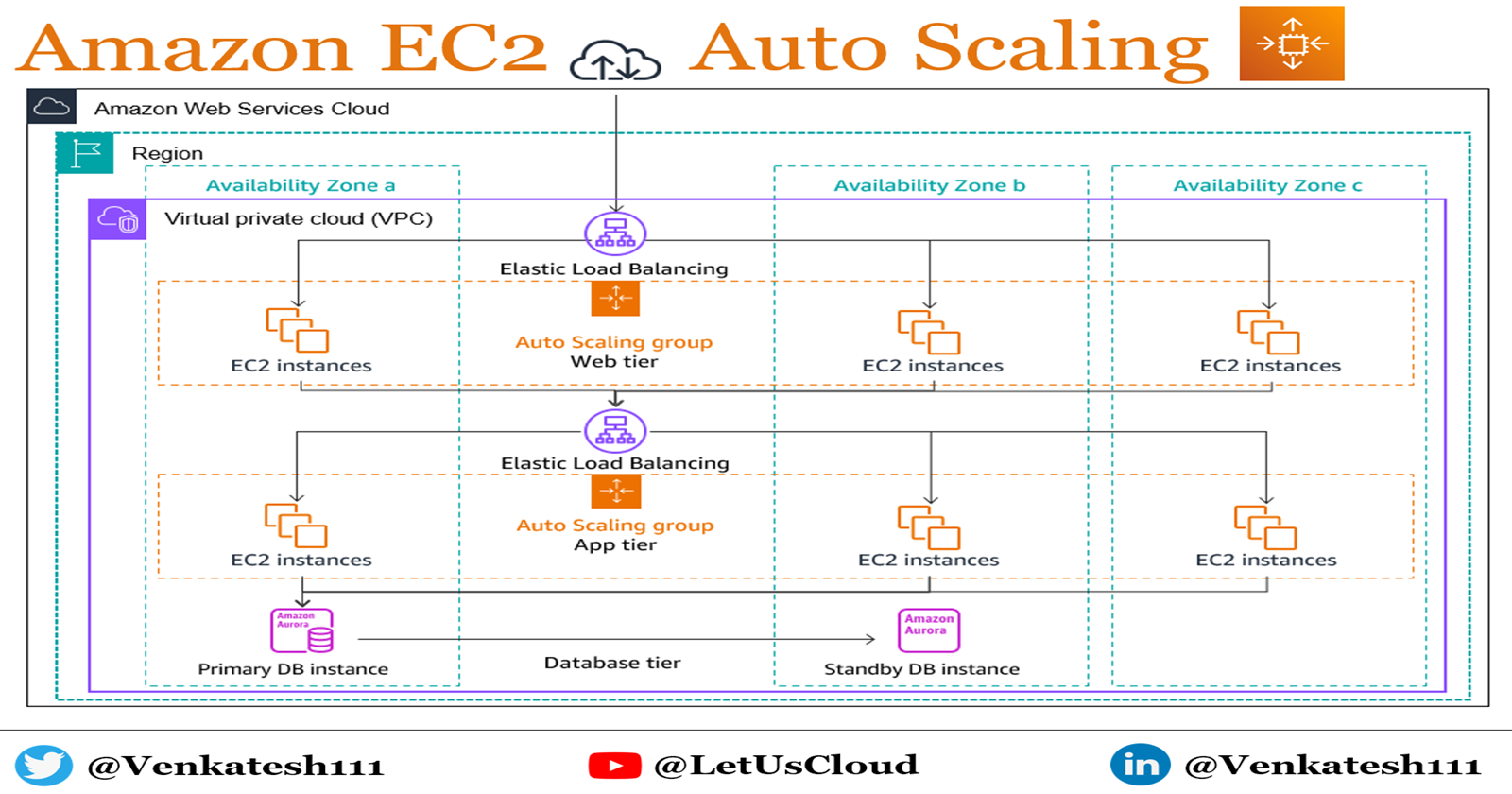
Auto Scaling
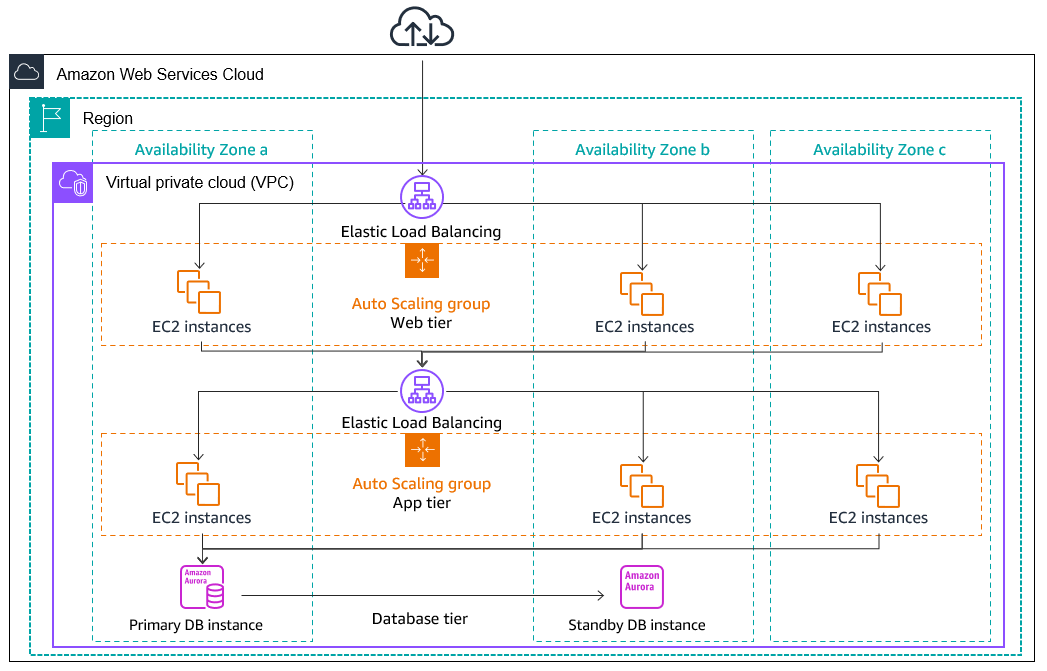
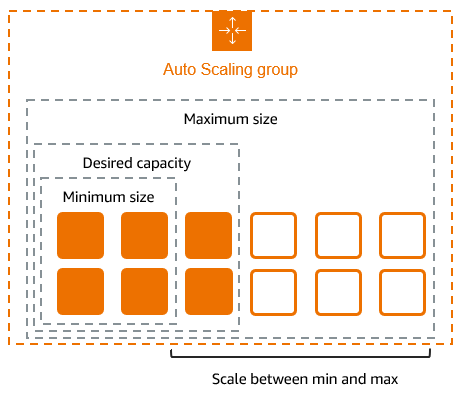
Auto Scaling Groups (ASG)
An Auto Scaling Group is a collection of EC2 instances that are treated as a logical grouping for the purposes of automatic scaling and management
ASG helps you automatically manage the scaling(in/out) of EC2 instances to meet the dynamic workload of your applications
ASG are
horizontal(increase or decrease in EC2 instance Count) ScalingThere are no additional fees with Amazon EC2 Auto Scaling, You only pay for the AWS resources (for example, EC2 instances, EBS volumes, and CloudWatch alarms) that you use.
Advantages of ASG
Fault tolerance
Amazon EC2 Auto Scaling can detect when an instance is unhealthy, terminate it, and launch an instance to replace it
You can also configure Amazon EC2 Auto Scaling to use multiple Availability Zones. If one Availability Zone becomes unavailable, Amazon EC2 Auto Scaling can launch instances in another one to compensate.
High Availability
- ASG helps ensure that your application always has the right amount of capacity to handle the current traffic demand
Better Cost Management
Amazon EC2 Auto Scaling can dynamically increase and decrease capacity as needed.
You pay for the EC2 instances you use, you save money by launching instances when they are needed and terminating them when they aren't.
Understanding the Need for Amazon EC2 Auto Scaling
Variable demand
Consider a basic web application running on AWS.
Purpose: Allows employees to search for conference rooms for meetings.
Usage pattern:
Minimal usage at the beginning and end of the week.
Increased usage in the middle of the week as more employees schedule meetings.
Graph below Displays the application’s capacity usage over the course of a week.
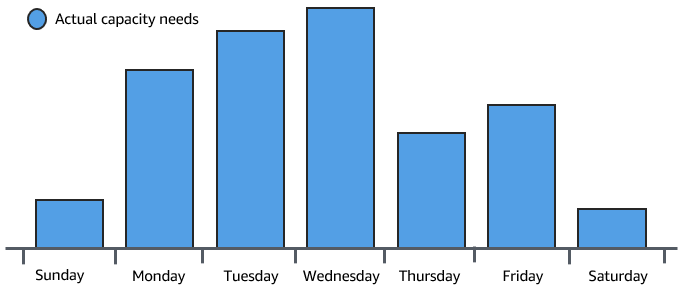
Traditional Capacity Planning Options:
Option 1: Add Enough Servers to Always Meet Demand
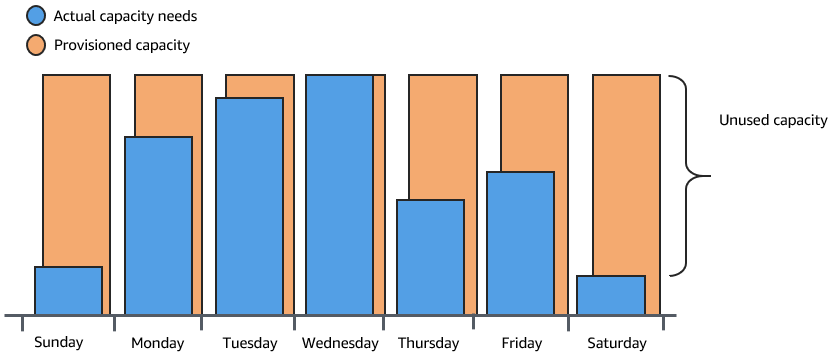
Ensures sufficient capacity at all times.
Downside: Extra capacity remains unused on low-demand days, increasing costs.
Example: Inefficiency of buying more capacity than needed.
Option 2: Handle Average Demand
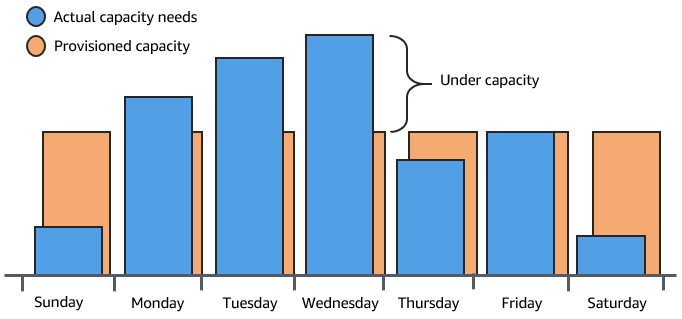
Less expensive as it avoids purchasing rarely used equipment.
Downside: Risk of poor customer experience when demand exceeds capacity.
Example: Poor customer experience due to insufficient capacity.
Amazon EC2 Auto Scaling:
Option 3: Dynamic Scaling
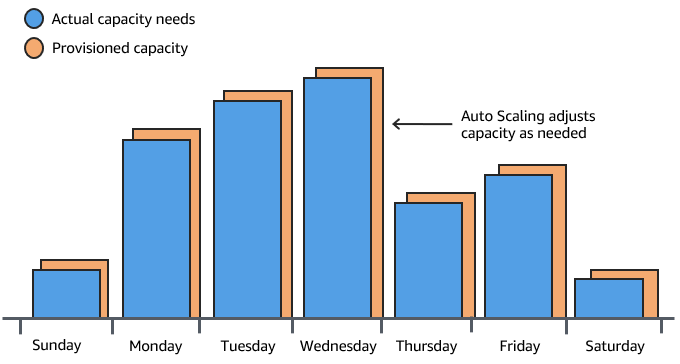
Adds new instances only when necessary.
Terminates instances when no longer needed.
Cost-effective: Pay only for the instances used.
Provides the best customer experience while minimizing expenses.
Example: Adjusting capacity as needed with Amazon EC2 Auto Scaling.
Balancing capacity across Availability Zones
The following image shows an overview of multi-tier architecture deployed across three Availability Zones.
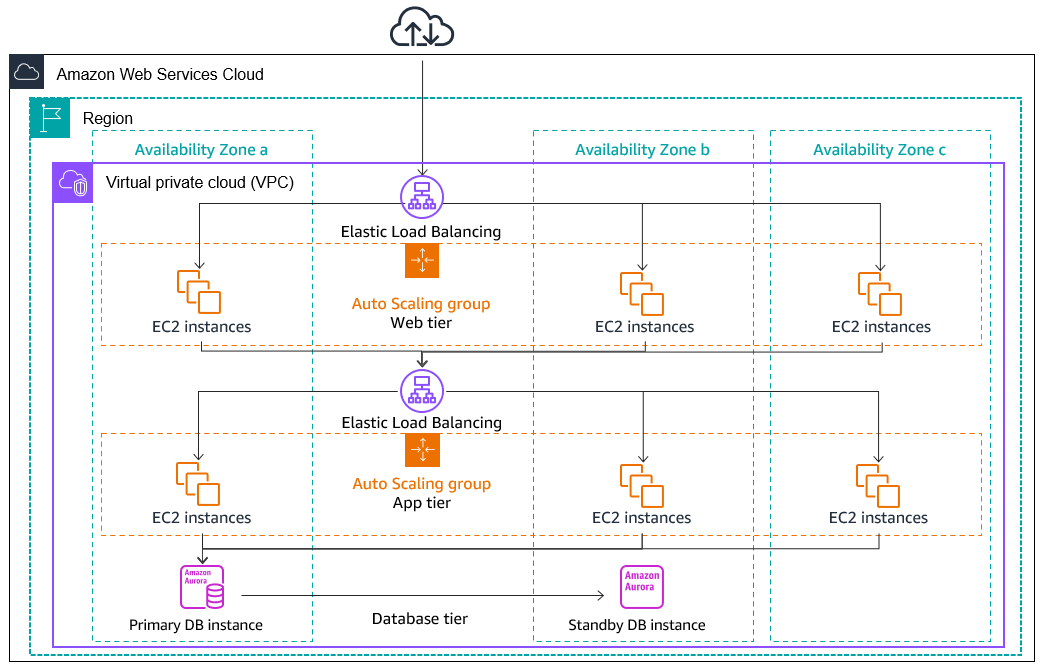
Instance Distribution:
Amazon EC2 Auto Scaling aims to maintain equivalent numbers of instances in each enabled Availability Zone.
It attempts to launch new instances in the Availability Zone with the fewest instances.
If multiple subnets are chosen for the Availability Zone, a subnet is selected at random.
If the launch attempt fails, it tries to launch instances in another Availability Zone until successful.
In cases where an Availability Zone becomes unhealthy or unavailable:
Instance distribution may become uneven across Availability Zones.
Upon recovery, Amazon EC2 Auto Scaling re-balances the Auto Scaling group.
It launches instances in the enabled Availability Zones with the fewest instances and terminates instances elsewhere.
Amazon EC2 Auto Scaling instance lifecycle
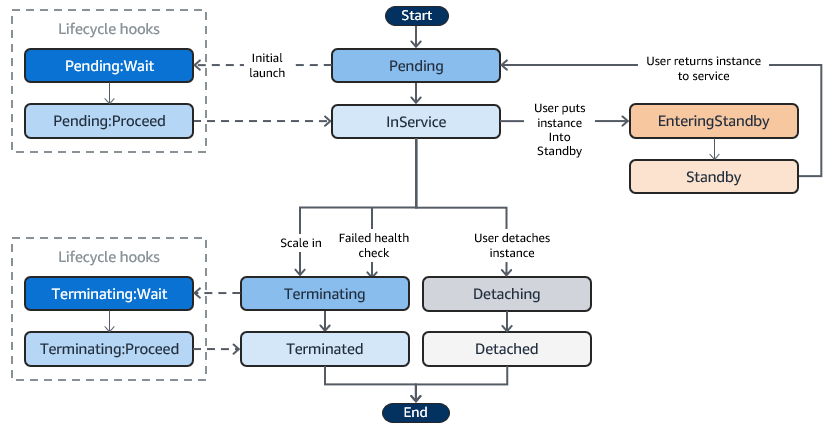
Start: The beginning of the instance lifecycle.
Pending: The instance is preparing to enter service.
Pending:Wait: A lifecycle hook where custom actions can be performed before the instance becomes active.
Pending:Proceed: The instance proceeds to the next state after the custom actions are completed.
InService: The instance is now serving traffic.
- User puts instance into Standby: The instance is manually moved to Standby state.
Standby: The instance is not serving traffic but is still part of the Auto Scaling group.
- User returns instance to service: The instance is manually moved back to InService state.
Terminating: The instance is in the process of being shut down.
Terminating:Wait: A lifecycle hook where custom actions can be performed before the instance is terminated.
Terminating:Proceed: The instance proceeds to termination after the custom actions are completed.
Terminated: The instance has been shut down and removed from service.
Detaching: The instance is being detached from the Auto Scaling group.
Detached: The instance has been successfully detached from the Auto Scaling group but not terminated.
End: The lifecycle of the instance has concluded.
Scale out, InService, Scale in
Scale out

Scale-Out Events: Direct Auto Scaling group to launch and attach EC2 instances.
Manual Increase: Manually increase the size of the group.
Scaling Policy: Automatically increase the size based on demand.
Scheduled Scaling: Increase the size at a specific time.
Scale-Out Process:
Auto Scaling group launches required EC2 instances using the launch template.
Instances start in Pending state.
Lifecycle Hook: Perform custom actions if added.
Instances fully configured and pass Amazon EC2 health checks.
Instances attach to Auto Scaling group and enter
InServicestate.Counted against desired capacity of the Auto Scaling group.
Load Balancer Integration:
If configured to receive traffic from an Elastic Load Balancing load balancer:
Auto Scaling automatically registers the instance with the load balancer.
Instance marked as
InServiceafter registration.
Instances in Service, InService
Instances remain in the
InServicestate until one of the following occurs:Scale-In Event: A scale-in event occurs, and Amazon EC2 Auto Scaling chooses to terminate this instance to reduce the size of the Auto Scaling group.
Standby State: You put the instance into a Standby state.
Detach Instance: You detach the instance from the Auto Scaling group.
Health Check Failure: The instance fails a required number of health checks, so it is removed from the Auto Scaling group, terminated, and replaced.
Scale in

Scale-In Events
Direct Auto Scaling Group: Detach and terminate EC2 instances.
Manual Decrease: Manually reduce the group size.
Scaling Policy: Automatically reduce the group size based on demand.
Scheduled Scaling: Reduce the group size at a specific time.
Scale-In Process
Instance Termination: Auto Scaling group terminates instances using its termination policy.
Terminating State: Instances enter the Terminating state and can't be put back into service.
Lifecycle Hook: Perform custom actions on terminating instances if added.
Complete Termination: Instances are fully terminated and enter the Terminated state.
Load Balancer Integration
De-registration: If using an Elastic Load Balancing load balancer, Auto Scaling automatically de-registers terminating instances.
Request Redirection: New requests are redirected to other instances, while existing connections continue until the de-registration delay expires.
Launch Templates
Launch Templates are instance configuration template that an Auto Scaling group uses to launch EC2 instances
Launch templates are similar to launch configurations
Key components of launch templates:
AMI ID
Instance type
Key pair
Security groups
Other EC2 instance parameters
Advantages over launch configurations:
Support for multiple versions
Ability to create subsets of parameters
Reusability across versions
Versioning benefits:
Can create a base configuration without AMI or user data
Add specific AMI and user data in new versions
Maintain general configuration parameters separately
Delete testing versions when no longer needed
Recommended over launch configurations for:
Access to latest features and improvements
Support for advanced features like:
Mixed Spot and On-Demand Instances
Multiple instance types in one Auto Scaling group
Compatible with newer EC2 features:
Systems Manager parameters (AMI ID)
Current generation EBS Provisioned IOPS volumes (io2)
EBS volume tagging
T2 Unlimited instances
Capacity Reservations
Capacity Blocks
Dedicated Hosts
Template creation:
All parameters are optional
Without an AMI specified, you can't add one when creating the Auto Scaling group
If AMI is specified but no instance type, you can add instance types when creating the group
Launch Template Versioning
The diagram below shows a single launch template with three versions:
Each version can add or modify parameters
Default version (Version 2 in this case) is used unless another version is specified
Allows for flexible configurations within a single launch template

Version 1
Includes:
t2.micro instance type
ami-1a2b
subnet-1111
key-pair-1
Basic configuration without security group
Version 2 (Default)
Builds on Version 1
Adds:
- sg-2222 (security group)
Set as the default version
Will be used if no specific version is requested when launching an instance
Version 3
Changes some parameters from previous versions
Uses:
t2.medium instance type
ami-3c4d
Keeps:
subnet-1111
key-pair-1 from Version 1
Adds:
- sg-3333 (different security group from Version 2)
Launch Templates Vs Launch Configuration
| Feature | Launch Template | Launch Configuration |
| Introduction | Newer and more flexible | Older and less flexible |
| Modification | Can be modified after creation | Cannot be modified once created |
| Versioning | Supports versioning | Does not support versioning |
| Use Cases | EC2 instances, Spot Fleets, and ASGs | Only ASGs |
| Configuration Changes | Allows partial changes | Requires full configuration for changes |
| Instance Types | Supports multiple instance types | Limited to a single instance type |
| AMI and Instance Type | Can be specified at launch time | Must be specified when creating |
| AWS Recommendation | Recommended for new deployments | Legacy option |
| Flexibility | More flexible and versatile | Less flexible |
| Updates | Can be updated | Cannot be updated, must create new |
ASG LifeCycle hooks
Lifecycle hooks are like a
pausebutton in Amazon EC2 Auto Scaling activityLifecycle hooks puts instances into a
wait stateto perform custom actions during launch or before termination.Instances remain in a wait state until the lifecycle action is completed or the timeout period ends.
default Timeout: 1 hour
Use cases:
Launch (Scale-Out) Hook: Installing software, run scripts, or configuring the instance before an instance goes into service.
Newly launched instance enters a wait state after startup
Run scripts to download and install necessary software
Ensure instance is fully ready before receiving traffic
Use
complete-lifecycle-actioncommand to continue
Terminate (Scale-In) Hook: Downloading logs, backup data, or perform any clean-up tasks before an instance is terminated.
Instance pauses before termination
Send notification via Amazon EventBridge
Allows actions like invoking AWS Lambda functions or connecting to the instance
Opportunity to download logs or other data before full termination
Examples:
Controlling instance registration with Elastic Load Balancing
Ensuring bootstrap scripts complete successfully
Verifying applications are ready to accept traffic
Registering instances to the load balancer after lifecycle hook completion
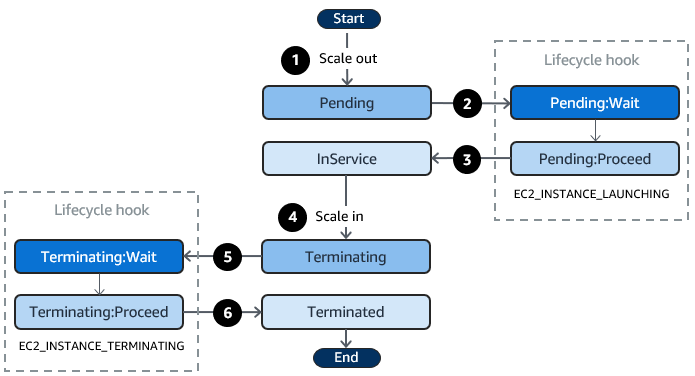
Scale-Out Event:
Instances launch and start in Pending state.
With
autoscaling:EC2_INSTANCE_LAUNCHINGhook:Move to Pending:Wait state.
Complete lifecycle action.
Move to Pending:Proceed state.
Fully configured instances attach to Auto Scaling group and enter InService state.
Scale-In Event:
Instances terminate and detach from Auto Scaling group, entering Terminating state.
With
autoscaling:EC2_INSTANCE_TERMINATINGhook:Move to Terminating:Wait state.
Complete lifecycle action.
Move to Terminating:Proceed state.
Fully terminated instances enter Terminated state.
ASG Warm Pool
warm pool helps to decreases latency for applications with long boot times.
warm pool ensures instances are ready to quickly start serving application traffic during a scale-out event.
Instances in the warm pool count toward the desired capacity when they leave the pool (known as a warm start).
Instance States: Instances in the warm pool can be in one of three states: Stopped, Running, or Hibernated.
Stopped: Minimizes costs, pay only for volumes and Elastic IP addresses.
Hibernated: Saves RAM contents to Amazon EBS root volume, pay for EBS volumes and Elastic IP addresses.
Running: Discouraged to avoid unnecessary charges.
Warm Pool Size:
Default size: maximum capacity - desired capacity = Default warm pool size
- Example: if maximum capacity = 10 and Desired capacity = 6 than Warm pool size = 10-6 = 4.
Custom size: Use
MaxGroupPreparedCapacityoption to set a custom value.- Example : Maximum capacity = 20, Desired capacity = 6, custom capacity = 8 than Warm pool size = 2.
Lifecycle Hooks:
Put instances into a wait state for custom actions during launch or termination.
Delay instances from being stopped or hibernated until they finish initializing.
Instance Reuse Policy:
Default: Terminates instances when scaling in and launches new instances into the warm pool.
Reuse Policy: Return instances to the warm pool instead of terminating them, ensuring the pool is not over-provisioned.
ASG Scaling
Scaling in AWS Auto Scaling Group (ASG) refers to the automatic adjustment of the number of EC2 instances in response to changes in demand for your application.
AWS ASG ensures that your application has the right amount of compute capacity at any given time by scaling out (increasing instances) or scaling in (decreasing instances) based on predefined conditions or policies
Scaling Out: Adding more instances to handle an increase in traffic or workload.
Scaling In : Reducing the number of instances when the demand decreases, saving costs.
Types of Scaling
1. Manual Scaling
Manually adjust the number of instances in the ASG.
Useful for predictable workloads or during testing.
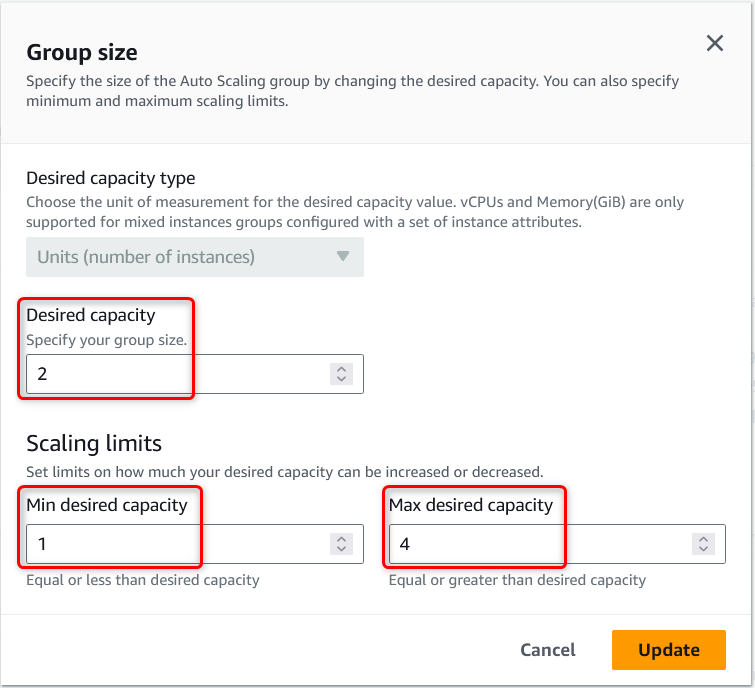
2. Automatic Scaling
Scheduled Scaling:
How it Works: Scale based on a schedule.Scales the number of instances up or down at predetermined times.
Example:
Maintain 4 desired instance 6 max and 2 min at specific time of the day.
Add 5 instances at 8 AM every weekday, remove 5 instances at 6 PM.
Use Case:
- Ideal for predictable load changes, such as daily or weekly traffic patterns.
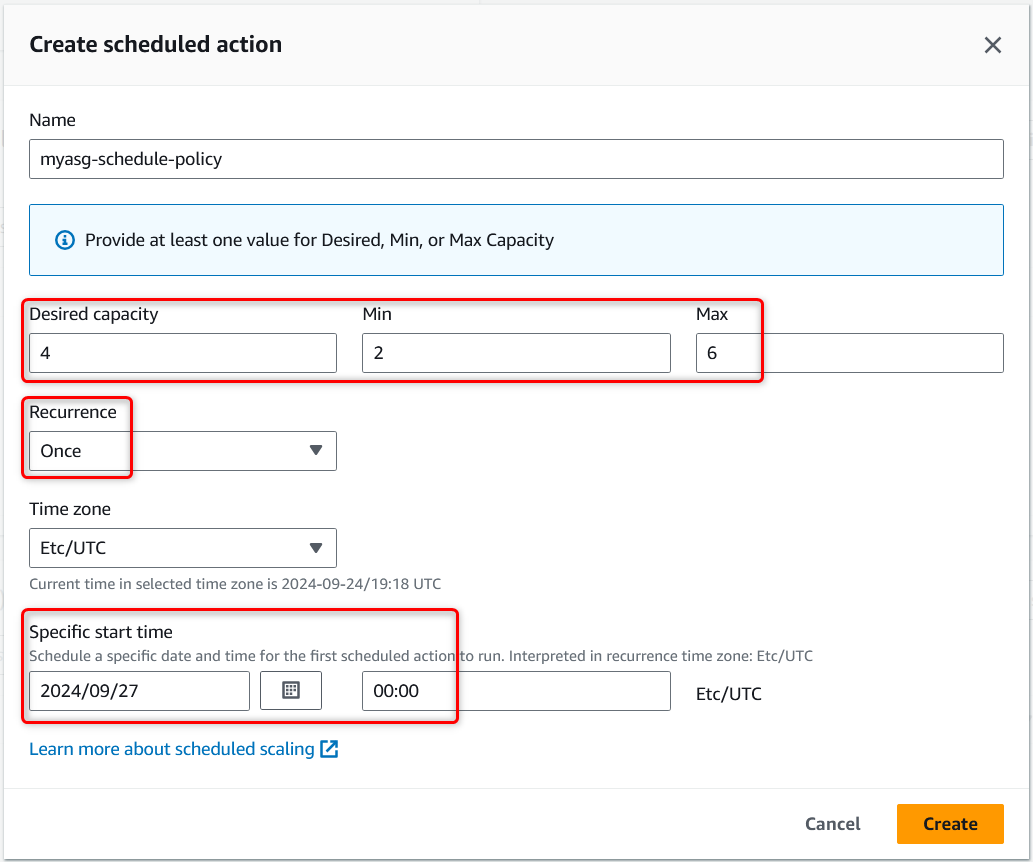
Predictive Scaling:
Uses machine learning to analyze historical load patterns.
Proactively scales capacity up or down based on predictions.
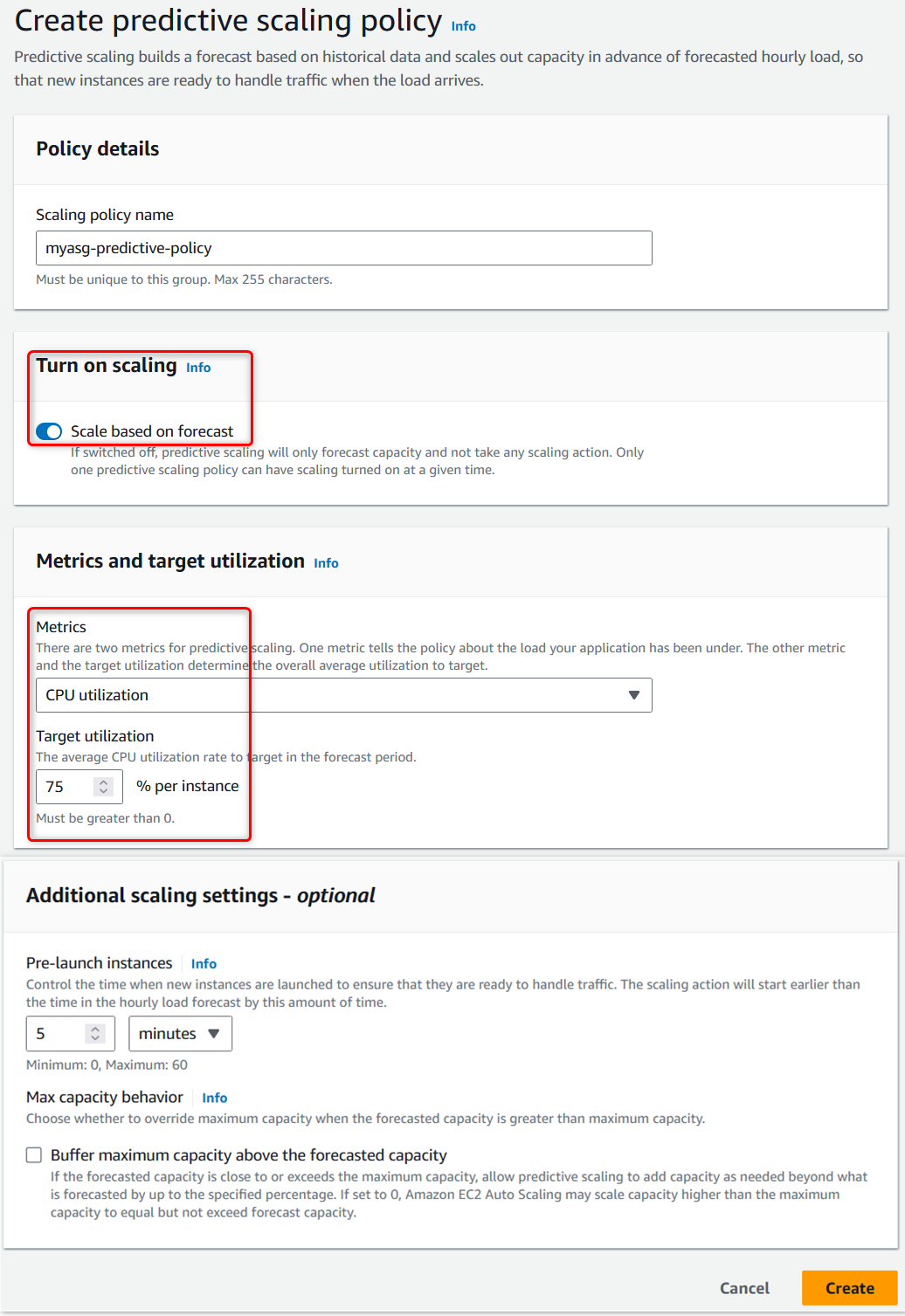
Dynamic Scaling:
Automatically scale based on real-time metrics.
Uses CloudWatch alarms to trigger scaling actions.
3 Types of Dynamic Scaling Policies
Simple Scaling
Step Scaling
Target Tracking Scaling
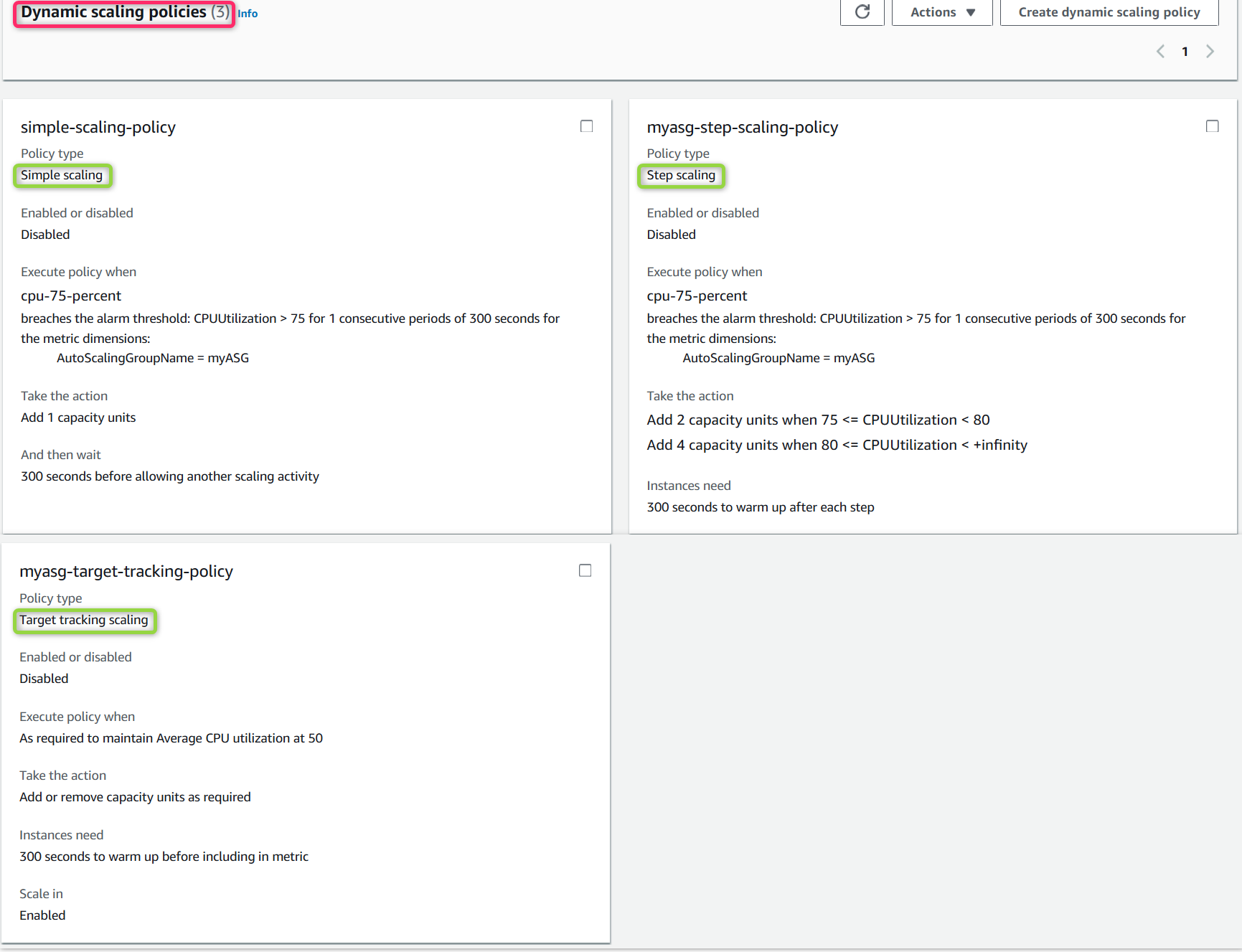
1. Simple Scaling Policy
How it Works: Adds or removes a fixed number of instances when a specific metric breaches a threshold.
Example: Add 1 instance when CPU utilization exceeds 75%, remove 1 instance when CPU falls below 30%.
Use Case: Suitable for basic scaling needs.
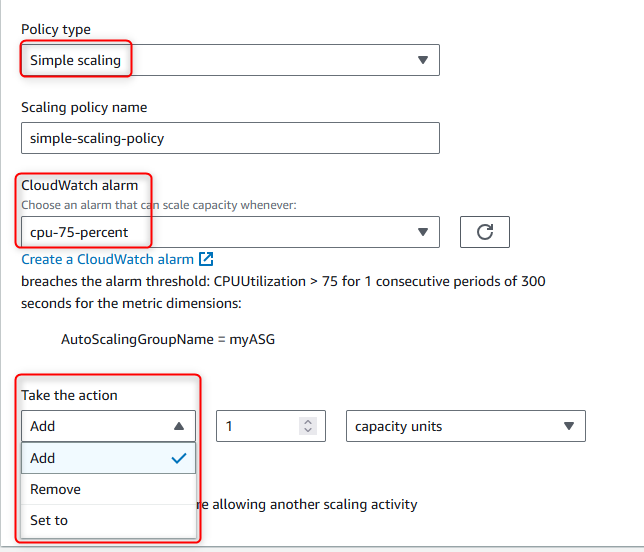
2. Step Scaling Policy
How it Works: Scales in steps based on how much the monitored metric deviates from the threshold.
Example:
CPU usage > 75%, add 2 instances.
CPU usage > 80%, add 4 instances.
CPU usage < 30%, remove 1 instance.
Use Case: Ideal for handling variable demand with predefined increments.
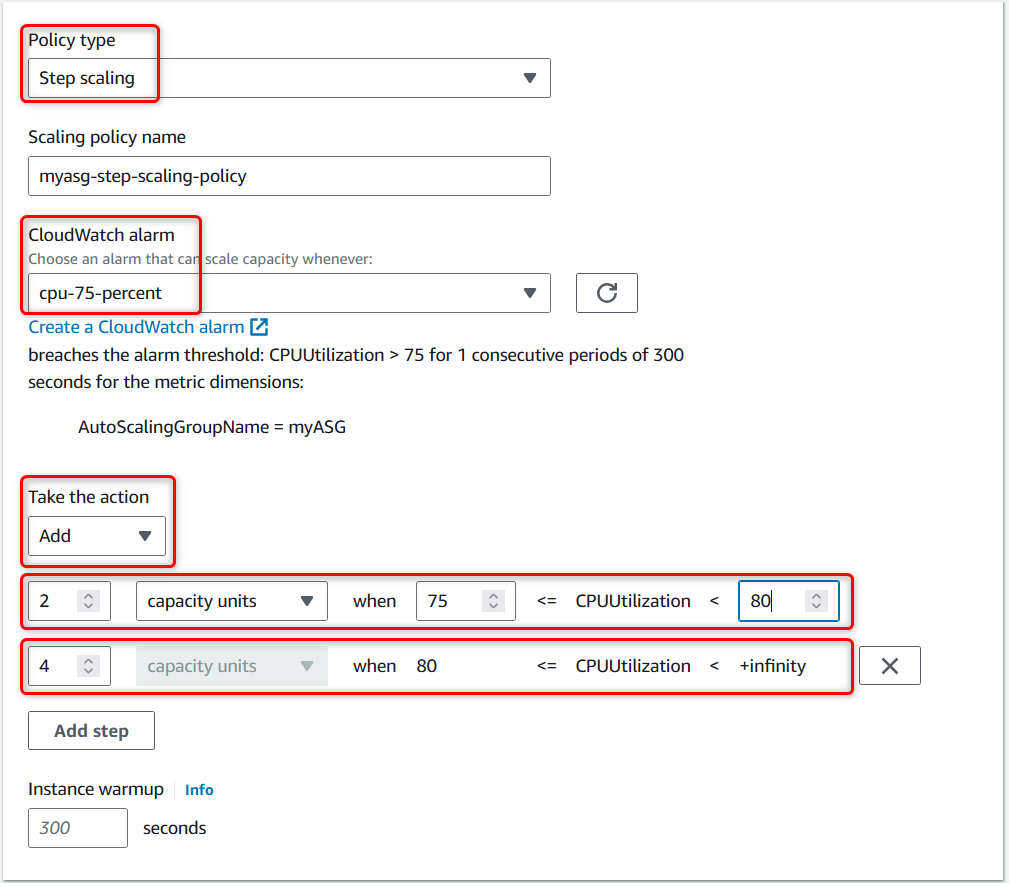
3. Target Tracking Scaling Policy
How it Works: Adjusts the instance count to maintain a target value for a specific CloudWatch metric (e.g., CPU utilization).
Example: Set a target CPU utilization to 50%. ASG will scale instances to maintain this target.
Use Case: Best for maintaining consistent performance.
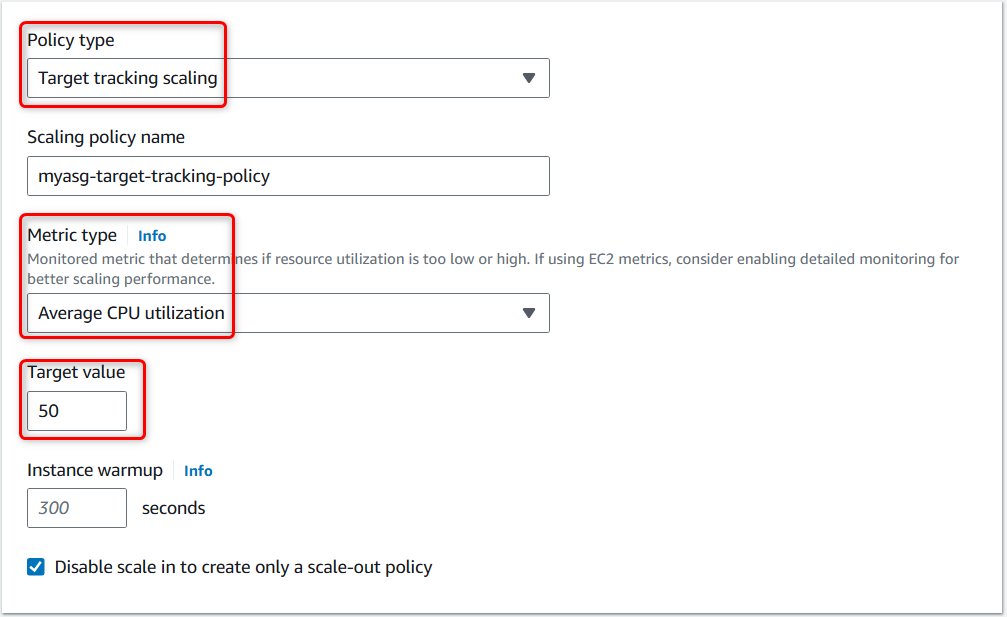
Comparison of Scaling Policies
| Scaling Policy | Trigger | Scaling Behavior | Use Case |
| Scheduled Scaling | Predefined time intervals | Scaling occurs at specified times | Predictable workload patterns |
| Simple Scaling | Metric breaches a threshold | Fixed increase or decrease in instances | Basic threshold-based scaling |
| Step Scaling | Metric exceeds/falls below thresholds | Scales in increments based on metric deviations | Variable traffic with sharp demand changes |
| Target Tracking | CloudWatch metric reaching a target | Scales to maintain a target metric | Continuous, steady-state applications |
References
https://aws.amazon.com/ec2/autoscaling/
https://docs.aws.amazon.com/autoscaling/ec2/userguide/auto-scaling-benefits.html
https://aws.amazon.com/blogs/compute/scaling-your-applications-faster-with-ec2-auto-scaling-warm-pools/
Subscribe to my newsletter
Read articles from Venkatesh K directly inside your inbox. Subscribe to the newsletter, and don't miss out.
Written by

Venkatesh K
Venkatesh K
Engineer | Cloud | DevOps | Automation | Trainer | AWS Community Builder